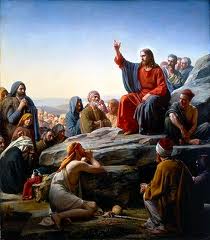 It is not new to understanding the heavenly portents and the “coming of the Son of Man” in Mark 13.24–27 as referring to the destruction of the Temple in 70 CE and the enthronement and vindication of Jesus, respectively. For a while now, R.T. France has proposed this interpretation of Mark’s account (as well as Matthew’s parallel).[1] Yet, beginning in v. 32 France argues that Mark is speaking of the parousia.[2] While France provides evidence for this interpretation, I am not convinced and find myself asking why we need to find evidence of the parousia in Mark’s account? I found consonance in N.T. Wright’s Jesus and the Victory of God, where he argues that Mark does not anticipate a descending Jesus at restoration and judgment, but rather speaks of the destruction and enthronement throughout ch. 13 (360–67). As far as Mark’s account is concerned, I am in agreement with Wright (I disagree with his assimilation of Matthew into this interpretation).
It is not new to understanding the heavenly portents and the “coming of the Son of Man” in Mark 13.24–27 as referring to the destruction of the Temple in 70 CE and the enthronement and vindication of Jesus, respectively. For a while now, R.T. France has proposed this interpretation of Mark’s account (as well as Matthew’s parallel).[1] Yet, beginning in v. 32 France argues that Mark is speaking of the parousia.[2] While France provides evidence for this interpretation, I am not convinced and find myself asking why we need to find evidence of the parousia in Mark’s account? I found consonance in N.T. Wright’s Jesus and the Victory of God, where he argues that Mark does not anticipate a descending Jesus at restoration and judgment, but rather speaks of the destruction and enthronement throughout ch. 13 (360–67). As far as Mark’s account is concerned, I am in agreement with Wright (I disagree with his assimilation of Matthew into this interpretation).
In line with Wright’s assessment, I found Timothy Gray’s monograph, The Temple in the Gospel of Mark: A Study in its Narrative Role, enlightening, as he argues that the narrative structure of Mark 11–15 focuses on the Temple. From chs. 11–13 the focus is on the earthly Temple and from chs. 14–15 the focus is on Jesus as the new Temple, and Mark 13.24–27 being the climatic turning point from old to new. Think about it: Mark 11 begins the accent into Jerusalem where Jesus pronounces a curse on a fig tree, curses the Temple leadership, and ends it with a withered fig tree. Jesus then returns to the Temple where his authority is impugned (vv. 27–33), which is followed by a parable condemning the Temple leadership (12.1–12) and further questions and teachings within the Temple precincts (12.13–41). Chapter 13 beings with Jesus and his disciples “coming out of the Temple,” looking back at the Temple, predicting the Temples destruction, and locating the group on the Mount of Olives “opposite the Temple” (13.1–3). So far the unequivocal central theme is “Temple,” which greatly suggests that the disciples questions in v. 4 are about the (1) the destruction of the Temple (2) and the signs leading up to its destruction. Thus, it makes sense that Jesus would proceed to answer the disciples questions and only the disciples questions. So when we come to Mark 13.24–25 and read about the sun becoming dark, the moon not given its light, the stars falling from heaven, and the “powers in the heavens” (gods?) shaking, the most natural referent is the destruction of the Temple. What else could he possibly be talking about? Has Mark failed to guide his readers to an unambiguous interpretation of Jesus’ discourse? There have been no clues since ch. 11 that he could be referring to anything other than the Temple.
Yet, against this last statement some may protest that the phrase, “coming of the Son of Man in the clouds” refers to the parousia. Maybe. But how does this relate to the heavenly portents? Taking an interpretation of “coming of the SoM” in vv. 26–27 and imposing it on the portents previously mentioned is tenuous. For one, doing this downplays the role of the Temple in Mark’s narrative and this is hardly endorsed by Mark! Mark is building up to a climactic end of the Temple, and if the portents describe the parousia, the climax for this destruction is removed. Furthermore, if the portents are taken as the parousia, the temporal flow of vv. 24–27 is redundant and resist the flow of the temporal markers καὶ τότε in vv. 26, 27. Verses 24–27 would thus speak of “the return of Christ (vv. 24–25), and then (καὶ τότε) the return of Christ (v. 26), and then (καὶ τότε) the sending of angels (v. 27). This repetition of the Advent is unnecessary and ignores the temporal markers. Thus, however one interprets vv. 26–27, the portents of vv. 24–25 must mark a distinct event.
But how does one interpret the “coming of the SoM?” At this point I do not wish to restate what Wright and France have argued so well concerning how this phrase could readily be understood as the enthronement and vindication of Jesus rather than the parousia.[3] I feel that their arguments are cogent and present a true portrait of a Jewish understanding of the Danielic text and how it would naturally be interpreted when used in Mark’s Gospel (or from Jesus’ lips). So in foregoing a detailed defense (which I may regret) of why I believe the “coming of the SoM” statement ought to be read as an enthronement oracle, I want to ask a few questions. Why do we feel a pressing need to find a descending Jesus in Mark’s account? Are we that eager to read Mark in light of Paul or (ironically) Matthew? Many of us are willing allow for diversity throughout the NT, but is the Second Advent off limits? Is it really that big of a deal if Mark envisions the restoration scene with Jesus sitting on the throne, while Paul and Matthew envision a descending Jesus? Restoration takes place either way, the only difference is Jesus is sitting or traveling. Granted, the predominant scenario of restoration from the second century to the present is the parousia, but should that be allowed to affect the way we interpret Mark’s account?
In the end I am arguing for a Mark that speaks of restoration but is silent concerning the “second coming” or parousia. For Mark, restoration was to occur at the enthronement and vindication of the Son of Man. This expectation was tightly wound around the destruction of the Temple, as the destruction of the old would inaugurate the new. …However, what are the Jesus followers to think following the Temples destruction and yet still awaiting restoration? In comes the Gospel of Matthew…



Good stuff.
The sentence “For Mark, restoration was to occur at the enthronement and vindication of the Son of Man” bothers me, because it implies a mistaken-ness on Mark’s part leading to a different Matthew. And this is arrived at by not argument, but scolding — “Why do we feel a pressing need to find a descending Jesus in Mark’s account? Are we that eager to read Mark in light of Paul or (ironically) Matthew? Many of us are willing allow for diversity throughout the NT, but is the Second Advent off limits?” These ad hominems detract from the argument. Why not state one or two reasons of France or Wright instead?
Larry, see McKinney’s follow-up post here: http://www.dburnett.com/?p=814
Larry, good to hear from you. Hope all is well.
I’m not sure I fully understand what it is that is “bothering you.” Is it the implication that Mark might have been incorrect? Is it that I am suggesting that Matthew and Mark are envisioning two different things with the same imagery?
The reason I asked these questions was because I wanted to engender a conversation not because I’m trying to prove anything by them. In hindsight though, I probably should have included some actual arguments. (I did mention that I would regret not giving any. I must be a prophet.)
Nevertheless, as David pointed out, I have since changed my opinion about what is going on with the Son of Man imagery. Actually, I wouldn’t say I have changed my mind as much as I am considering another option.